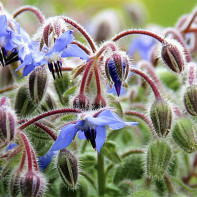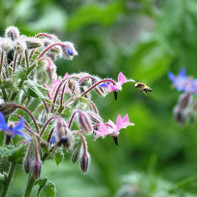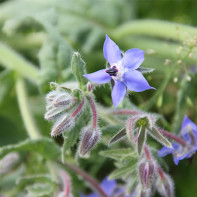Cucumber grass: useful properties and contraindications
On Russian open spaces and in the CIS countries, cucumber grass is perceived as a weed. For this reason, we do not have such a welcoming attitude to this plain-looking plant as in Europe, where it is specially grown for culinary needs. Europeans cook borages, as this herb is also called, salads, drinks, add it to dishes as seasoning. Our borage is mainly used in folk medicine as an additional tool to the main treatment. Due to its unique composition and useful properties, healing herbs are in demand in cosmetology.
- Chemical composition
- How it looks and where it grows
- Kinds
- Collection and storage
- Collection rules
- Drying
- How to prepare flowers
- Useful properties of cucumber grass
- Cucumber herb in folk medicine
- Remedies for joint and muscle pain
- Prescription for insomnia and neurosis
- Remedy for cystitis and inflammation of the kidneys
- Tonic tea
- Cold medicine
- Slimming juice
- In oncology
- The use of borago in cooking
- Honey dessert
- Refreshing lemonade
- Salads
- Cold Borago Soup
- Application in cosmetology
- Mask for oily hair
- Mask for dry skin
- Hand Care
- Composition for weak hair
- Types of healing compounds
- Infusion
- Tincture
- Decoction
- Borago oil: properties and applications
- Contraindications
Chemical composition
The interest of culinary specialists and traditional healers in cucumber grass is caused by its rich composition, in which there are a lot of substances useful for the body. In a modest annual contains several dozen valuable components, among which are:
- ascorbic acid present throughout the terrestrial part of the plant;
- carotenes;
- fatty acids in seeds;
- mineral elements: potassium, iron, calcium, magnesium;
- mucous components necessary to soften the affected tissues and mucous membranes;
- organic acids;
- tannins;
- flavonoids;
- esters in flowers.
The composition of the plant is stable both in fresh and in dried form. Therefore, people who practice traditional medicine methods are always engaged in the procurement of this valuable plant material.
Borago has a very low calorie rate - only 21 units in a 100-gram serving of greens. For this property, the plant is highly regarded by nutritionists.
How it looks and where it grows
Borage - a plant unpretentious, but loves warmth. The main botanical characteristics of annual grass:

- Habitat. Grass for its residence chooses open places along the roads, in vacant lots, in ravines. Syria is considered the birthplace of the annual, from where it quickly spread to all regions of Europe and North Africa. Nondescript grass is found in the Caucasus and Ukraine. These are mainly wild plant species.
- Affiliation. The borage belongs to the Buranchikov family, hence another name for this wild culture - the gimlet. Sometimes it is called a heart flower.
- External signs. Outwardly, the annual looks unattractive, although during the flowering period it is difficult not to notice pretty blue or purple hue inflorescences resembling small panicles.
- Height. The borage reaches a height of 60–80 cm, but sometimes you can find bushes more than 1 m high.
- Stem. The thick stem of the plant, covered with whitish villi, deserves special attention. It is straight at the bottom, and strongly branched up. The stem contains juices, which are very much appreciated in cooking and traditional medicine.
- Flowering period. Borago has a long flowering period - from June to August. At this time, 5–12 mg of sweet nectar accumulates in each flower, which attracts bees. Therefore, the gimlet is one of the best melliferous plants.
- Leaves. In the basal zone, the leaves of Bornago are large, they have an oval shape. On the stem, the foliage is smaller, but each leaf, like a stem, is covered with villi.
- Fruit. In place of each flower closer to autumn, a fruit is formed in the form of a tuberous nut of dark brown color.
- The aroma. The aroma of borago grass resembles a cucumber smell, which served as the emergence of such a name - borage. True, the similarities of these two cultures end there, that is, cucumbers, and the grass buranchik are not related plants.
- Reproduction. Borage is very resistant to living conditions, and its habitat is constantly expanding due to high fecundity. Grass propagates by the self-seeding method: the boxes ripened at the end of summer are opened, and the seeds disperse, expanding their living space every year. Therefore, very often you can meet thickets.
Note: thickets of wild borago are very difficult to breed, which complicates the life of European farmers. But in North Africa, annuals are grown specifically for culinary needs.
Kinds
Basically, gardeners cultivate a medicinal little ginger, from which valuable raw materials are then obtained for the preparation of homemade preparations. In cooking, the cultivated vegetable varieties of the borage are widely used:
- Gnome. Very resistant to low temperatures. It has a powerful cucumber aroma and branched stem.
- Vladykinskoye Semko. This artificially obtained variety is distinguished by large leaves with a terry fringe.
Also popular among gardeners are varieties: Okroshka, April and Brook.
For decorative decoration of personal plots, two varieties of borage are used:
- Alba Variety with white large inflorescences.
- Variegata. Variegated variety of decorative borago.
Collection and storage
In cooking, fresh young shoots of borage are most valued because they have tender juicy flesh. Old specimens quickly turn into a tough and inedible green mass. For the preparation of medicinal compositions, it is also desirable to use the young ground part of the plant. Therefore, herbalists are advised to collect foliage in the first few weeks of the plant's life.
Collection rules
It is best to collect green foliage in spring. The time for collecting seeds and inflorescences is not limited to 2-3 weeks. Since the borage flower blooms all summer, during this time you can collect useful plant materials. Just keep in mind that ripened seeds spontaneously spill out into the ground. Therefore, they must be collected with extreme caution, from July to September. In order to prevent self-seeding, experienced gardeners gently shake the seeds into paper caps every day, and cover the soil near the holes with plastic wrap.
Drying
Inflorescences and leaves can be dried in their entirety, but it is better to cut, and then lay it out on a paper sheet under a canopy. The draft will dry well on a draft, which eliminates the risk of a putrefactive process. Grass dried by this method can be used in winter for almost any purpose. But healing tea with borago is especially useful.
How to prepare flowers
The situation is a little more complicated. Specialists recommend sugaring them. This method of preservation allows you to maintain all the useful qualities, and in addition to the winter diet, which is scarce on vitamins, you can always have a tasty treat at hand. The procurement process in stages:
- Harvest fresh flowers. First, cook a thick syrup according to the formula: take 2 parts of sugar for a portion of water.
- When the syrup is ready, cool it, and then coat each flower with it, and then dip it in powdered sugar.
- To simplify the implementation of such a delicate procedure, it is best to fill in an ordinary salt shaker with icing sugar, then gently sprinkle the flower petals out of it.
Another option for preparing flowers for winter storage:
- Place the finished flower buds on a baking sheet covered with a sheet of parchment, and then send them to dry in the oven for 2.5 hours.
- After drying, be sure to check the flower mass so that there are no wet places.
- Dry flowers are most conveniently arranged in jars. But you need to work with such a fragile product very carefully.Whole fruits in the form of nuts are not suitable for long-term storage.
Good to know: maximum taste characteristics are manifested only in cultivated varieties of cucumber grass.
Useful properties of cucumber grass
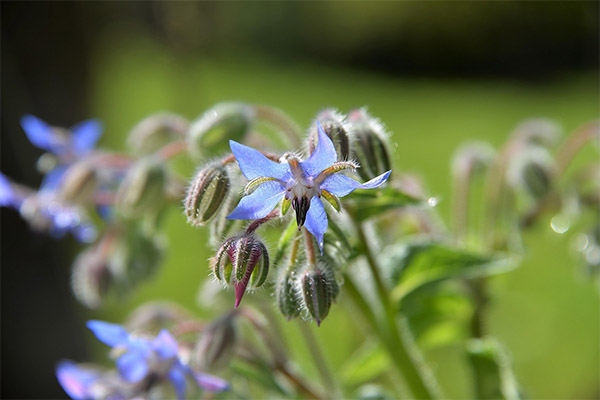
Saturated with vitamins and minerals, the composition of borago grass allows us to judge its healing properties. Moreover, it is enough to add it to the food in the form of seasoning or as an additional ingredient, so that the body receives substantial support. It is no accident that cucumber herb is included in many dietary supplements, and in some European countries it is included in the pharmacopeia. We list the useful properties of cucumber grass, and it has a lot of them:
- sweatshops;
- moderate laxative;
- expectorant;
- diuretic;
- anti-inflammatory;
- enveloping;
- painkiller;
- sedative.
The plant stimulates the production of adrenaline and increases lactation in nursing women. Traditional healers recommend the use of useful grass in the following pathological conditions:
- sleep disturbances;
- depressive states;
- malfunctioning kidneys;
- joint pain
- gout;
- asthenic syndrome;
- constipation
- colitis;
- colds;
- rheumatism;
- upper respiratory tract infections;
- skin lesions;
- swelling
- neurosis of the heart.
Borage increases metabolism, so it should be added to dishes with weight loss.
For both medicinal and culinary purposes, fresh plant material and dried parts of annual grass are equally useful.
Cucumber herb in folk medicine
The ancient Romans attributed borago mythical abilities. During the conquests of the great empire, it was believed that the “blue-eyed” grass was able to strengthen the fighting spirit of warriors and heal severe wounds. From historical documents it is known that the legendary Spartans before the decisive battles drank a decoction of borage in order to overcome fear and defeat the enemy.
But even after millennia, the gimlet does not cease to be in demand in alternative medicine. On the basis of the plant, medicinal drinks and products for external processing are prepared. It is included in diet food for various diseases to strengthen immunity and restore internal resources of the body.
Today, borago is widely used in various homeopathic remedies. And traditional healers propose to use simple medicines based on this useful plant that have been tested for centuries in home practice.
Here are some simple recipes involving this unique herb that can be used in the treatment of various diseases.
Remedies for joint and muscle pain
Recipe 1. An infusion prepared from 1 tbsp will help get rid of an unpleasant symptom. fresh borago herb inflorescences brewed in a glass of boiling water. The medicine should be infused for an hour, and then it can be taken 1 tbsp. up to 3 times a day.
Recipe 2. To increase the effectiveness of treatment can be due to the external use of a concentrated composition based on the borage. Only in this case, the portion of the main component must be increased to 3 tbsp. dry grass. After boiling the base with boiling water, let the solution stand under the lid for 15–20 minutes. Then apply a warm compress to the affected area. In this way, burns, ulcers and bruises on the skin surface are treated.
Prescription for insomnia and neurosis
Fresh juice of the plant has unique abilities: it heals, soothes, lowers the temperature, and helps to cope with insomnia. Preparing the drug is simple:
- A small amount of fresh leaves of borage (it is better to take the lower leaves), first rinse under running water, then rinse with boiling water, and then pass through a meat grinder.
- Press the resulting green mass.
- All the juice that was able to be extracted after the previous manipulations was diluted with water in equal proportions, and then boiled for 2-3 minutes.
- Take medicine after meals. Single dose - 2 tbsp.
This composition can be used to treat problem areas of the dermis.
Remedy for cystitis and inflammation of the kidneys
This is a universal recipe that can also be used for gastritis with low acidity. The principle of preparation of the healing composition is the same as described in previous recipes. Shredded dried borago inflorescences (1 tablespoon) are used only as a basic raw material. Stand the infusion for 6 hours, and then take 1/2 cup. The number of receptions is 3-4.
Tonic tea
For the preparation of an invigorating drink, dry plant material and fresh herbs or flowers are suitable. Tea is prepared from the fruits of hawthorn, borago, oregano and tatarnik grass. Grind plant materials thoroughly. Take all the ingredients exactly 1 tsp, mix. Brew herbal mix with boiling water. Infuse tea for 6-8 hours. Take the finished drink twice a day in half a glass. The tool is recommended for people prone to depression.
Cold medicine
The main ingredients:
- borage;
- coltsfoot;
- plantain;
- thyme;
- oregano
- elderberry (inflorescences).
Mix all of the listed components in the proportions: 2: 2: 2: 3: 3: 3: 2. Then from the obtained herbal collection take 3 tbsp. raw materials, pour 2 cups of boiling water over it. Insist the medicine for about half an hour. Take 100 ml per dose before meals with cough and other symptoms of the common cold.
Slimming juice
For weight problems, it is recommended to drink freshly squeezed borage juice twice a day for 2 tbsp. It is recommended to mix vegetable nectar with water in half. It is good to combine borage and celery. Both plants are among the most active fat burners.
In oncology
To reduce intoxication in such diseases, it is recommended to drink a drink made from equal parts of the flowers and leaves of borage with white cabbage. Bring all plant components to a state of gruel, add honey. Take 1 tbsp. up to 4 times a day.
The use of borago in cooking
Mostly fresh parts of the plant are used for food. Due to its specific aroma, borago often replaces a real cucumber in dishes. Plants are added to soups and salads, sauces and smoothies, alcoholic beverages, and even sweet desserts. In European countries, plant flowers are used in the food industry as a component for confectionery and skates, and mature leaves are added to pickles and marinades. Italians believe that their traditional ravioli tastes better with borage grass.

Braised borago leaves can be served as a standalone dish. In a word, the scope of such a useful plant as borage in cooking can be very diverse. Therefore, it is worth taking note of a few simple recipes involving this herb.
Honey dessert
We need to take a suitable container, and best of all a 0.5 liter jar. Pour honey first, and lay a flower layer about 1 cm thick on top. In this sequence, alternate layers until the jar is filled to the top. Store the treat in a dark place.
Alternatively, honey can be replaced with sugar. True, then the result will be flower sugar, which is also no less tasty. Proportions: for a 100-gram serving of granulated sugar - a full glass of flower buds.
Refreshing lemonade
In hot time, a thirst of lemonade prepared from the simplest composition will quench your thirst:
- borago (fresh herbs);
- lemon;
- melissa or parsley.
Borage (leaves) grind in a blender with parsley, add finely chopped lemon. Pour the base with several glasses of plain water. You can supplement the composition with agave syrup, and before serving, put an ice cube in a glass.
Salads
A variety of salads are prepared from borago grass. We offer two options for vegetable snacks.
Option 1. This dish is often called a “warm” salad. The cooking method is simple: finely chop dill, onion feathers, borage, parsley. Then mix the green mass with warm mashed potatoes, and pour the sour cream on top of the finished dish.This snack should be eaten immediately after cooking, otherwise the taste of the dish will deteriorate.
Option 2 This is a recipe for borage salad with horseradish. Finely chop the borage, combine the greens with the boiled potato slices, sprinkle everything with grated horseradish, and salt. The dish can be seasoned with sour cream.
Cold Borago Soup
The product set includes:
- 4 potatoes;
- bulb;
- a couple of carrots;
- canned peas;
- 20 g of borago;
- sour cream for dressing;
- salt.
How to cook:
- Cut peeled potatoes into slices and send to boiling water.
- When the potatoes are cooked until half cooked, add grated carrots and chopped onions into the broth.
- Add peas from a can at the end of the preparation.
- Remove the soup from the heat and only after that add salt, add chopped borage, spices, sour cream.
Application in cosmetology
For home cosmetic procedures, borago oil is most suitable. It has a high content of vitamins, gamma-linolenic and other fatty acids. The proper use of such a useful product will help normalize the sebaceous glands and deal with the most common skin problems. Borago oil improves the condition of the hair and strengthens the nail plates, helps get rid of dandruff and cure even complex forms of dermatitis. For example, a few recipes for home use.
Mask for oily hair
Mix 1 tsp. borage extract with tea tree oil (4 drops) and lemon juice (5 drops). Mix everything well, and then apply this composition to the basal part of the hair. Leave the mask for an hour, then rinse with warm water.
Mask for dry skin
A mask made from the following components will improve the appearance of dehydrated facial skin:
- egg yolk - 1 pc.;
- borago oil - 1 tsp;
- orange oil - 3 drops.
After mixing the ingredients, immediately apply to the face. After half an hour, wash with warm water.
Hand Care
It will soften and significantly rejuvenate the skin of the hands, and also strengthen the nails with a mixture of jojoba, borago, coconut oils. Take all components in equal parts. It is recommended to perform the procedures before bedtime. Rinse off the composition is not required, because it is very quickly absorbed into the skin of the hands.
Composition for weak hair
It is known that hair suffers most from staining and perm. They become dry and brittle, outwardly look lifeless. A simple mask of two components will help to fix the situation: sea buckthorn oil and borage, taken equally. After mixing, warm the composition in a water bath. Apply a warm product to the scalp, then wrap it with polyethylene, and on top still wrap your head in a towel. The mask should last 2 hours, after which the composition should be washed off with ordinary shampoo.
Extras: borago oil is ideal for everyday care. It can be added to regular cream or lotion. This valuable product is especially useful during menopause, when age-related changes are clearly manifested.
Types of healing compounds
Based on cucumber grass, you can prepare a variety of dosage forms. All known recipes are not difficult, and their preparation takes only a few minutes. The most popular remedy in folk medicine is an infusion of borago. A healing drink is prepared according to one scheme: first, pour the raw materials with boiling water, and then insist for a certain time. Depending on the purpose of using the drug in different formulations, the dosage of the starting ingredients may vary.
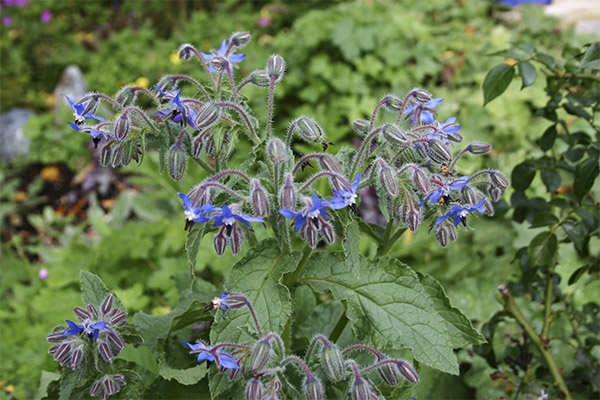
Infusion
This is a concentrated infusion intended for external processing.
Dried ground part of the plant (6 tablespoons) pour a glass of boiling water. Close the container tightly with a lid. Leave the infusion for 20 minutes, so that the beneficial components of the plant are activated in the water.Use the solution for compresses and treatment of affected skin.
Tonic infusion
A remedy prepared according to this recipe can be drunk to replenish energy resources of the body, for example, after hard physical work or training.
Preparation Scheme: take 1 tbsp. fresh borage inflorescences and shredded stems. Pour boiling water over the base, insist under the lid for a quarter of an hour. Take this medicine for no more than 10 days.
Tincture
Water tincture of borago is prepared as the basis for external procedures. For this purpose, the dried leaves of the plant are more suitable. Take such a handful full of such raw materials (3-4 tablespoons), fill the raw materials with chilled boiled water. Close the dishes with a lid. Insist 30-40 minutes. Then you can make compresses to treat burns, wounds, skin ulcers.
Decoction
To restore the strength of warriors in antiquity, it was borago broth used. It is prepared from all terrestrial parts of the plant. Usually used dried plant material.
Classic broth recipe:
- Take 20 g of dry leaves, pour them with 0.5 l of water, put on low heat.
- Boil the base for 10-15 minutes.
- When the broth cools down, filter it. Take 1 tablespoon before meals. thrice a day.
This tool perfectly helps with joint pain, it is recommended to take it during a cold, with skin problems and nervous breakdown.
Borago oil: properties and applications
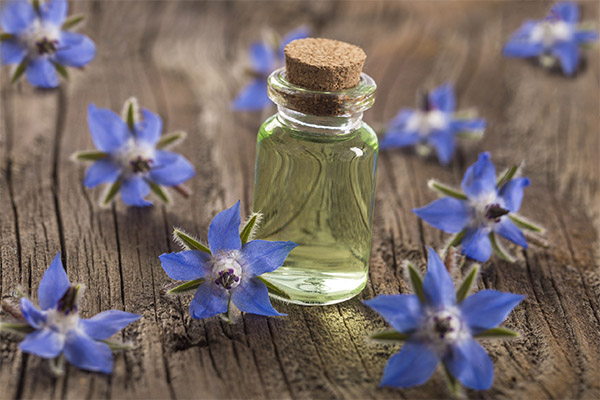
In cosmetology, borago oil is most in demand. This valuable product can be purchased at the pharmacy. Cooking butter on your own is very difficult. Oil extract has a number of useful properties:
- relieves acne;
- returns elasticity and freshness to aging skin;
- Helps maintain normal water balance
- accelerates the regeneration of damaged tissues;
- perfectly nourishes and moisturizes the dermis;
- removes wrinkles;
- provides gentle cleansing;
- strengthens hair.
In addition to the above actions, the borage is able to effectively solve the problem of cellulite and stretch marks. Borago oil is usually added to cosmetic masks.
Often, the product is part of therapeutic agents for various diseases. For example, it is often taken orally with gastritis and to cleanse the body. As an alternative to natural oil, ground plant seeds can be used. If such a medicine is taken daily for 1 tsp, the body will be cleaned of toxins, and skin and hair in response to such care will shine with health and beauty.
An important point: after opening the bottle with oil, you should try to use it faster, since the product is subject to oxidative processes. The maximum shelf life in the refrigerator after opening is 2 months. This period can be extended by adding a few drops of wheat germ oil to the bottle.
Contraindications
Although there are many positive qualities of cucumber grass, one can not ignore the risk of side effects during its application. An absolute contraindication for the use of this plant is:
- individual intolerance;
- epilepsy;
- schizophrenia and other mental disorders.
In addition, you need to remember the following recommendations:
- Borago grass should not be taken for more than three weeks, as this can adversely affect the condition of the liver.
- Despite the fact that the gimlet increases lactation, nursing mothers should first consult a doctor, and then take an infusion of herbs.
- Uncontrolled administration of drugs for peptic ulcer and gastritis can trigger an exacerbation of pathology.
- Pregnant women should also be extremely careful with this plant.
- It is best to use a borage in combination with other medicinal plants.
- It is forbidden to combine the internal use of compositions based on the borage with anticoagulants.
In other cases, borago grass is completely safe, in small quantities it is allowed to give even to children.
As you can see, cucumber grass, despite its nondescript appearance, is able to provide the body with effective help. In this case, the plant is not demanding on the conditions of existence. Even a few modest bushes grown in the garden on their own will be a valuable source of vitamins and raw materials for the preparation of home remedies. Of course, one can argue about the culinary possibilities of this plant. But European gourmets do not accidentally include a borage in a huge number of dishes, and then enjoy their piquant taste.
«Important: all information on the site is provided exclusively in fact-finding purposes. Before applying any recommendations, consult with a profile specialist. Neither the editors nor the authors are liable for any possible harm caused materials. "

